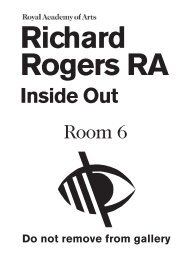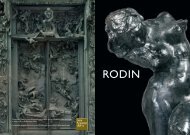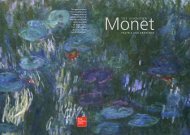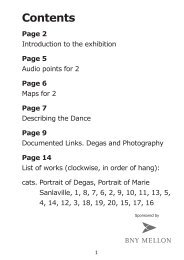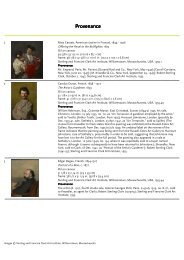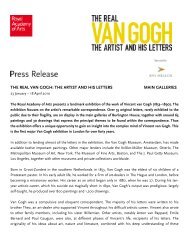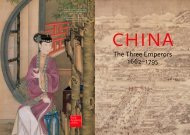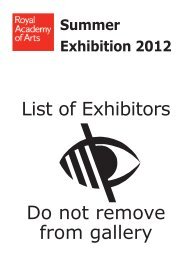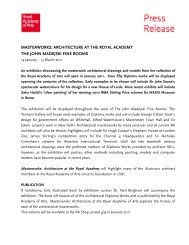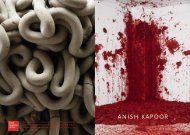KIRCHNER - Royal Academy of Arts
KIRCHNER - Royal Academy of Arts
KIRCHNER - Royal Academy of Arts
Create successful ePaper yourself
Turn your PDF publications into a flip-book with our unique Google optimized e-Paper software.
‘The most recent movement<br />
in painting…seeks to simplify<br />
and intensify the forms <strong>of</strong><br />
expression, to achieve new<br />
rhythms and colourfulness,<br />
to create in decorative or<br />
monumental forms…the<br />
movement [is] known as<br />
Expressionism.’<br />
Catalogue preface for the Sonderbund<br />
exhibition held in Cologne in 1912<br />
‘Visual art should give images,<br />
not impressions; instead <strong>of</strong><br />
rapid impressions it should<br />
give deepened expression<br />
and intensification <strong>of</strong> being.’<br />
Hermann Obrist, founder <strong>of</strong> an art<br />
school Kirchner attended in Munich<br />
‘After the Gauguin exhibition,<br />
non-Western sources became<br />
for Kirchner the essential raw<br />
material for the ultimate<br />
attainment <strong>of</strong> a personal style.’<br />
Donald Gordon,<br />
‘Kirchner in Dresden’ article, 1966<br />
day and night…poets, painters and musicians all working together to<br />
create “the art <strong>of</strong> the century”, an incomparable art towering timelessly<br />
over the art <strong>of</strong> all past centuries.’<br />
In Italy, the Futurists reacted by celebrating technology and speed in<br />
dynamic compositions that <strong>of</strong>ten involved moving mechanical elements,<br />
while in France, Pablo Picasso and Georges Braque suggested the<br />
dislocation <strong>of</strong> modern life by fragmenting forms in pictorial experiments<br />
which would later be given the name Cubism. At the same time in Germany,<br />
this impulse towards artistic experimentation yielded a surprisingly unified<br />
response in the form <strong>of</strong> Expressionism.<br />
An influential art movement which emerged during the first decade<br />
<strong>of</strong> the twentieth century, German Expressionism reacted against the cold<br />
and austere classicism <strong>of</strong> the historical painting that had dominated the<br />
nineteenth century. Instead, it advocated a highly emotional and subjective<br />
response to modern, urban stimuli and strived above all to reveal the inner<br />
emotional truth <strong>of</strong> objects, people and experience. As Magdalena M. Moeller,<br />
the Director <strong>of</strong> the Brücke-Museum, remarks: ‘The German artist looks<br />
not for harmony <strong>of</strong> outward appearance but much more for the mystery<br />
hidden behind the external form. He or she is interested in the soul <strong>of</strong><br />
things, and wants to lay this bare.’<br />
In works which favoured brilliant colour and expressive forms, the<br />
German Expressionists took many <strong>of</strong> their visual cues from Post-<br />
Impressionism, at the same time anchoring their art deeply within the<br />
German tradition. The emotive style <strong>of</strong> the Post-Impressionist artist<br />
Vincent van Gogh – his turbulent brushwork and belief in the manipulation<br />
<strong>of</strong> colour for emotional impact – was in sympathy with the Expressionists’<br />
aim to communicate a deepened expression <strong>of</strong> their subjects’ essence.<br />
Also highly influential was Paul Gauguin, whose lifelong interest in tribal<br />
sculpture and the art <strong>of</strong> the Pacific Islands was eagerly adopted by the<br />
German Expressionists. They were attracted by ethnographic art’s ‘primitive’<br />
or ‘naïve’ qualities – in particular, its simplified, exaggerated forms – which<br />
appeared innocent and timeless in comparison with the modern world <strong>of</strong><br />
technology and ephemera.<br />
Cat. 7<br />
Two Nudes<br />
Oil on canvas, 1906/8<br />
This exuberant depiction <strong>of</strong> two nudes was painted soon after the<br />
formation <strong>of</strong> the Brücke group, when Kirchner was just twenty-six years<br />
old. It is likely to have been painted in Kirchner’s Dresden studio which,<br />
although dingy, was exotically furnished with freshly-painted canvases,<br />
carved sculptures and colourful batik wall hangings. With its kaleidoscope<br />
<strong>of</strong> pure, bright colours and its thick, impasto brushstrokes, the painting is<br />
clearly Expressionist in its technique. If you compare it with Kirchner’s later<br />
works, you’ll see that it appears to have been painted at an interesting<br />
3




